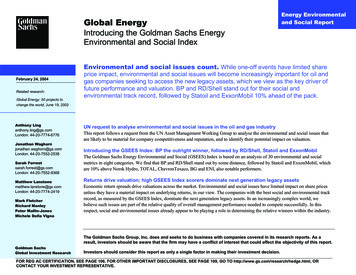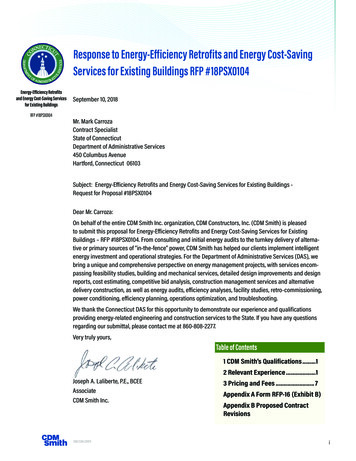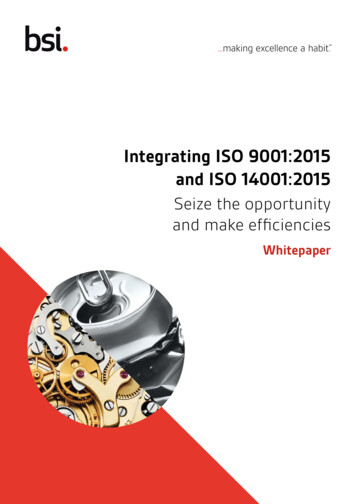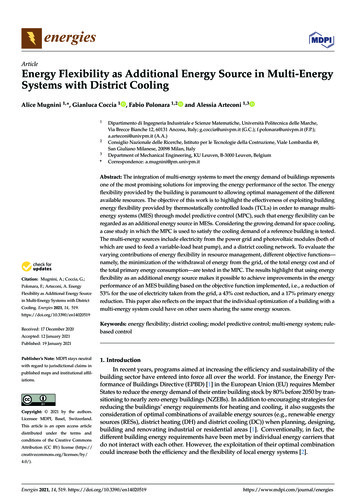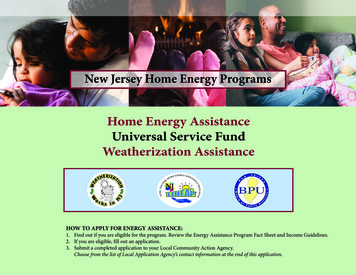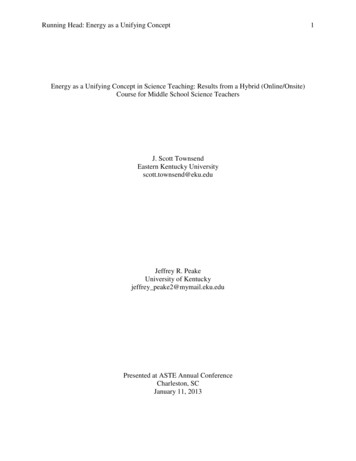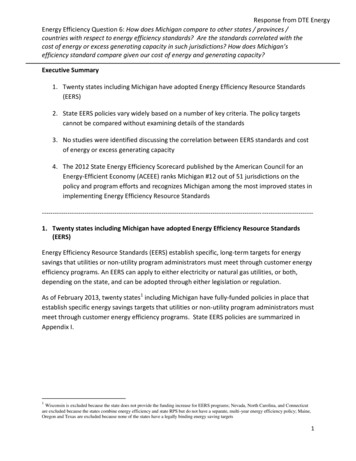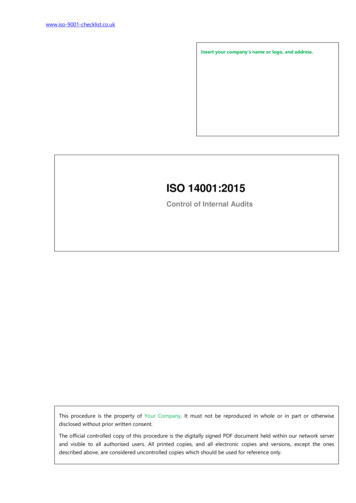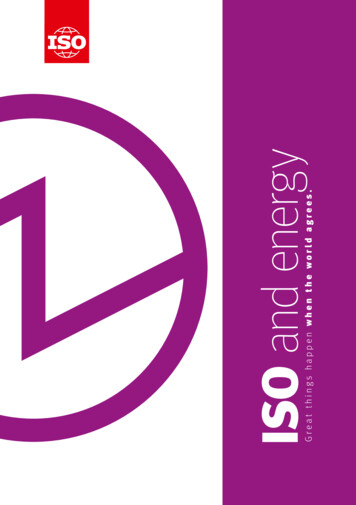
Transcription
Great things happen when the world agrees.ISO and energy
We are ISO,the International Organizationfor Standardization161*members22 000*International StandardsWe are an independent,non-governmental organization.100We are a global network ofnational standards bodies withone member per country.245new standards each month*technical committeesOur job is to make InternationalStandards.We are coordinated by a CentralSecretariat in Geneva, Switzerland.We are not for profit : selling ourstandards allows us to financetheir development in a neutralenvironment, to maintain themand to make new ones.ISO provides a platform fordeveloping practical tools throughcommon understanding andcooperation with all stakeholders.* July 2018
Why do we need ISO standardsfor energy ?Over 1.2 billion people around the world do not have access toelectricity, yet world energy production is at its highest ever and isexpected to increase by up to 30 % by 2030*. What’s more, the earth iswarming at unprecedented rates, largely due to man-made greenhousegases that are causing havoc to our climate. Increasing energyefficiency and the use of renewables is key to meeting the world’senergy demands while contributing to global targets to reduce carbonemissions.* United Nations 2018 : www.un.org/sustainabledevelopment/energyISO works through its network of nationalmembers to bring together the foremostinternational expertise on energy issues.ISO standards represent consensus onconcrete solutions and best practice forenergy efficiency and renewables.Energy is the majorcontributor to climatechange, making up60 %of total greenhousegas emissions*.* United Nations 20184ISO standards help organizations reducetheir energy consumption and adoptrenewable energy technologies. They alsoensure interoperability, which encouragesthe transition to renewable energy sources,opening up markets for innovations thataddress the global energy challenge.ISO standards for energy help us movetowards “ affordable and clean energy for all ”,one of the United Nations SustainableDevelopment Goals, the new global roadmapto improve people’s lives by 2030.
Who benefits from ISO standardsfor energy ?IndustryISO standards can help organizations, large orsmall, to save energy and costs, while activelycommitting to sustainability. This gives them acompetitive advantage through products andprocesses that are more energy-efficient andenvironmentally friendly.RegulatorsRegulators can rely on ISO standards forinternationally harmonized solutions thatare continually reviewed and improved.These provide a solid technical basethat governments can use to achievetheir national and international energyobjectives and commitments.ConsumersISO standards help make government schemesmore effective and improve the efficiency ofelectrical appliances and other energy sources.They also help consumers reduce their energyconsumption and costs while contributing toglobal energy efficiency goals.
What energy sectors does ISO cover ?ConstructionIndustrial productsand processesRenewable energyPower generation8IT and householdappliancesWind powerTransportHydrogen
What standards does ISO have for energy ?Out of a total of over 22 000 InternationalStandards, ISO has more than 200 relatedto energy efficiency and renewables, withmany more in development.Below is a selection of ISO’s standardsfor energy:Carbon capture and storageISO has published a number of standardsthat facilitate the use of this innovativetechnology, which consists of extractingcarbon dioxide (CO2) emissions from largestationary sources and injecting them intoa geologic storage formation for safe andsecure disposal. ISO/TC 265, Carbon dioxide capture,transportation, and geological storageEnergy managementIn addition to ISO 50001 on energymanagement systems (see Box overleaf),our most widely used energy-relatedstandard, ISO has developed standardson energy performance indicators, themeasurement, analysis and verification ofenergy performance, as well as methodologies for the calculation of energy savingsin projects, organizations and regions. ISO/TC 301, Energy managementand energy savingsWho developsISO standards ?ISO standards are developedby groups of experts withintechnical committees(TCs). TCs are made up ofrepresentatives from industry,non-governmental organizations,governments and otherstakeholders who are putforward by ISO’s members.Each TC deals with a differentsubject ; in the energysector, for example, thereare committees focused onmeasuring CO2 emissions,energy management andbuilding design, as detailedin this brochure.9
Environmental managementAlongside ISO 14001 for environmental management,ISO 14064 on the quantification and reporting ofgreenhouse gases and ISO 14025 on environmentallabels and declarations are just some of the manystandards that help organizations reduce theirenvironmental impact through smarter energy usage. ISO/TC 207, Environmental managementISO 50001 for energy managementISO 50001:2018, Energy management systems – Requirements withguidance for use, is one of ISO’s most widely used standards, withover 20 000 certifications issued in 2016 alone (up 70 % from 2015),not to mention the organizations that use it without getting certified.It provides organizations with a recognized framework for developingan effective energy management system. Like other ISO managementsystem standards, ISO 50001 follows the Plan-Do-Check-Act processfor continual improvement.Many companies, big and small, have reported benefits from usingISO 50001 ; examples can be found in the dedicated ISO 50001 brochure.10
BuildingsEnergy consumption in buildingsaccounts for over 20 % of total primary energy use worldwide 1), andup to 40 % in developed economies such as the United States andthe EU 2), and it is on the rise.ISO has a number of standardsthat help make buildings moreenergy-efficient, coveringeverything from the design of thewhole building to its individualparts. This includes the ISO 52000family of standards, which takes aholistic approach to improving theenergy performance of buildings.It contains a comprehensivemethod of assessing energyperformance as the total primaryenergy used for heating, cooling,lighting, ventilation and domestichot water of buildings, thussupporting new technologies andapproaches to building design andmanagement. ISO/TC 163, Thermalperformance and energy usein the built environment ISO/TC 205, Buildingenvironment design1) www.eia.gov/outlooks/ieo/pdf/0484(2017).pdf2) 81630578311
Information technologyStandards that address the performanceof information and communicationtechnology (ICT) and household appliances arekey players in reducing energy consumption.The new ISO/IEC 30134 series of standards,developed in conjunction with the InternationalElectrotechnical Commission (IEC), aims tomake ICT products more energy-efficient. ISO/IEC JTC 1/SC 39, Sustainability forand by information technology12
TransportNew technology is making inroads in reducingthe energy consumption and pollutingemissions of vehicles, but there is still a longway to go. ISO standards help pave the wayfor these technologies by providing usefultools to support their development. Theseinclude standards such as ISO 16923 andISO 16924 for the design and operation ofstations dispensing compressed and liquefiednatural gas to vehicles, ISO 8714 for measuringthe reference energy consumption of electricpassenger cars, and ISO 23274 for measuringexhaust emissions and fuel consumption inhybrid vehicles. Other related documentsfeature ISO/TS 19880, a technical specificationthat recommends the minimum safetycharacteristics for hydrogen fuelling stations.In addition, the ISO 6469 series providessafety specifications for rechargeable energystorage systems for electric cars. ISO/TC 22/SC 37, Electrically propelledvehicles ISO/TC 197, Hydrogen technologies13
Industrial productsand processesISO has standards to increase theperformance and effectiveness ofmachines and equipment, includingrefrigeration and air-conditioningsystems, automation systems, industrialfans, air and gas cleaning equipment andmore. ISO/TC 115, Pumps ISO/TC 117, Fans ISO/TC 184, Automation systems andintegrationRenewablesISO has published over 50 standardsfor solar energy systems and biofuels,namely standards for performanceratings and test methods, solar heating,solar panels and solid biofuels. Futuretechnical work will cover solar thermalcollectors and the safety of solid biofuelpellets. ISO/TC 180, Solar energy ISO/TC 238, Solid biofuels14
Energymanagement andenergy savingsBuildingenvironmentdesignISO/TC 301Automationsystemsand integrationHydrogentechnologiesISO/TC 197EnvironmentalmanagementISO/TC 205PumpsFansISO/TC 184ISO/TC 115ISO/TC 117ISO/TC 238SolidbiofuelsISO/TC 207ISO/TC 163ISO/TC 265Thermalperformance andenergy use in thebuilt environmentCarbon dioxidecapture,transportation, andgeological storageISO/TC 180SolarenergyISO/IEC JTC 1/SC 39Sustainabilityfor and byinformationtechnologyISO/TC 22/SC 37Electricallypropelledvehicles17
More information ?@ISO Websitewww.iso.orgISO Website section on energywww.iso.org/iso/energyISOfocus magazinewww.iso.org/isofocusYoutubeISO Follow us on Twitterwww.iso.org/twitterJoin us on Facebookwww.iso.org/facebookJoin us on GooglePluswww.iso.org/gplus
InternationalOrganizationfor StandardizationISO Central SecretariatChemin de Blandonnet 8Case Postale 4011214 Vernier, GenevaSwitzerlandiso.org ISO, 2018All rights reservedISBN 978-92-67-10829-2The symbol on the cover comes fromthe International Standard ISO 7000,Graphical symbols for use on equipment– Registered symbols. It is used to identifythe control or the indicator for electric energy,or to identify equipment that is operated byelectric energy.Available on our Online Browsing Platform at :gotoi.so/isosymbols.
for solar energy systems and biofuels, namely standards for performance ratings and test methods, solar heating, solar panels and solid biofuels. Future technical work will cover solar thermal collectors and the safety of solid biofuel pellets. ISO/TC 180, Solar energy ISO/TC 238, Solid biofuels

